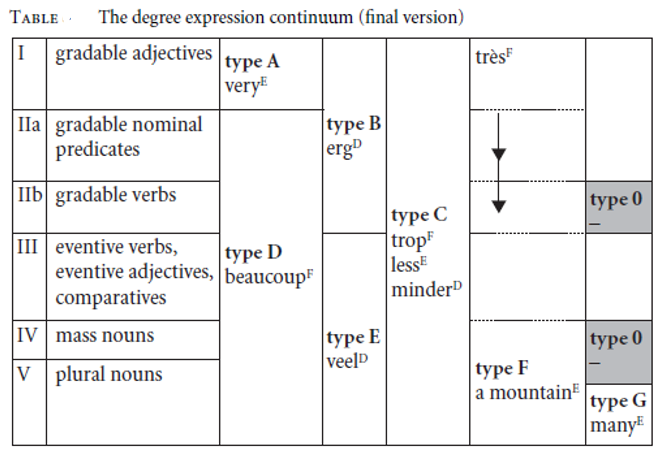


 Grammar
Grammar
 Tenses
Tenses
 Present
Present
 Past
Past
 Future
Future
 Parts Of Speech
Parts Of Speech
 Nouns
Nouns
 Verbs
Verbs
 Adverbs
Adverbs
 Adjectives
Adjectives
 Pronouns
Pronouns
 Pre Position
Pre Position
 Preposition by function
Preposition by function 
 Preposition by construction
Preposition by construction
 Conjunctions
Conjunctions
 Interjections
Interjections
 Grammar Rules
Grammar Rules
 Linguistics
Linguistics
 Semantics
Semantics
 Pragmatics
Pragmatics
 Reading Comprehension
Reading Comprehension|
Read More
Date: 2025-04-13
Date: 7-1-2022
Date: 26-2-2022
|
Adjectives and degree modification Summary
Given the discussion so far, we can introduce a completed version of the degree expression continuum in Table 1 It is important to realize that the different types are not meant to be an exhaustive inventory of static types. In many cases individual members may have slightly different properties at the “borders” of their distribution. An example is English much, which usually does not combine with plurals, unlike the other members of type D, and which also combines with certain adjectives. Also, an expression might have the distribution of a type C expression except for the fact that it is incompatible with plurals; this is actually the case for mycket ‘a lot’ in Swedish (Muriel Norde, p.c.).

The semantic properties of the different types can be summarized as follows. There are no obvious meaning differences between types A, C, and D. Type B (erg, horribly) is clearly distinct from a semantic point of view (see also the discussion on Dutch tig above). This seems to be due to the origin of these expressions, which are bleached adverbial modifiers with a high or very high degree interpretation. Similarly, most type F expressions contain a measure word (e.g. a mountain of ) and have a high degree (of quantity) meaning. Type E (e.g.Dutch veel) seems to be in complementary distribution with type B and therefore inherits the meaning restrictions on type B.
|
|
|
|
تحذير من "عادة" خلال تنظيف اللسان.. خطيرة على القلب
|
|
|
|
|
|
|
دراسة علمية تحذر من علاقات حب "اصطناعية" ؟!
|
|
|
|
|
|
|
شركة اللواء العالمية تعرض منتجاتها في الأسبوع الزراعي السادس عشر في بغداد
|
|
|